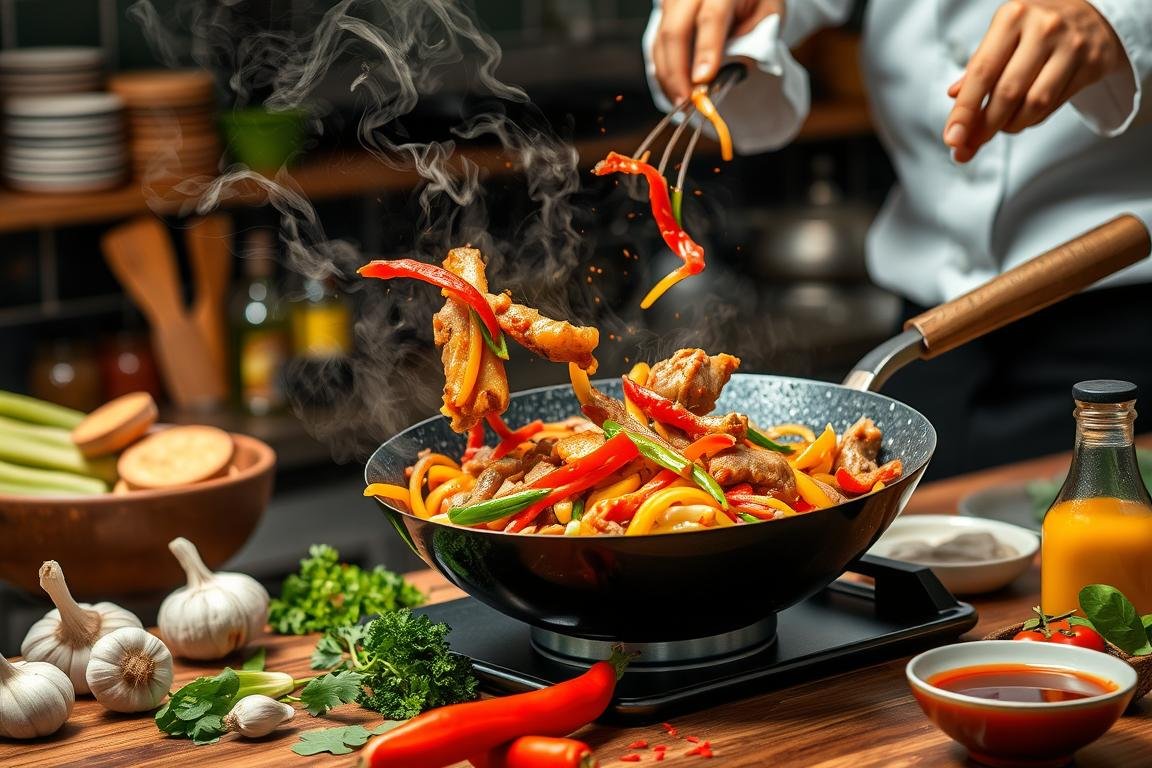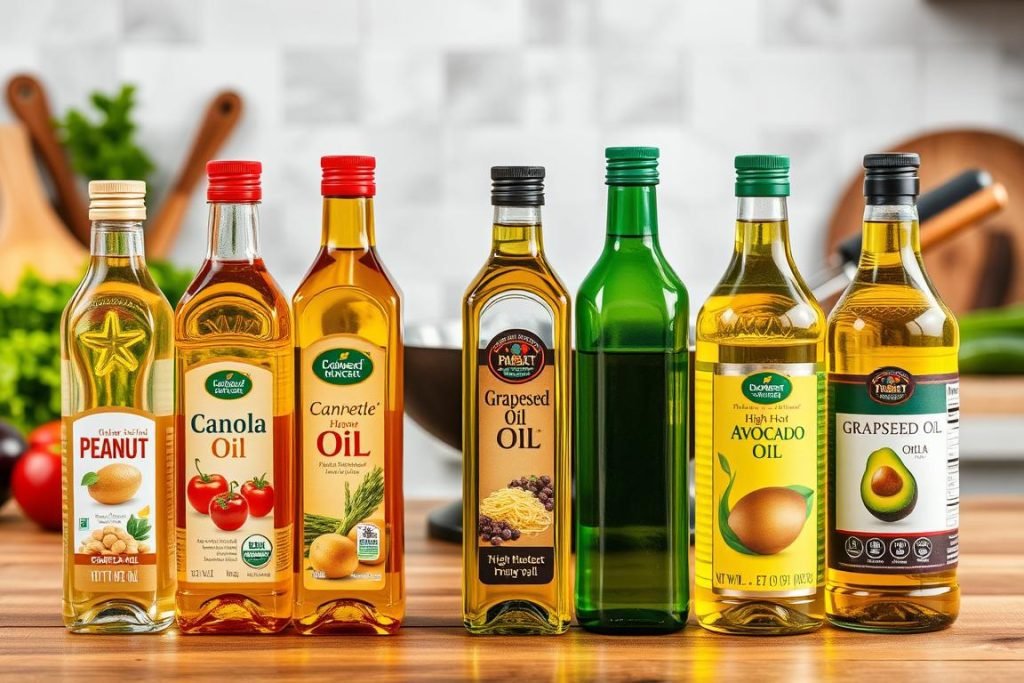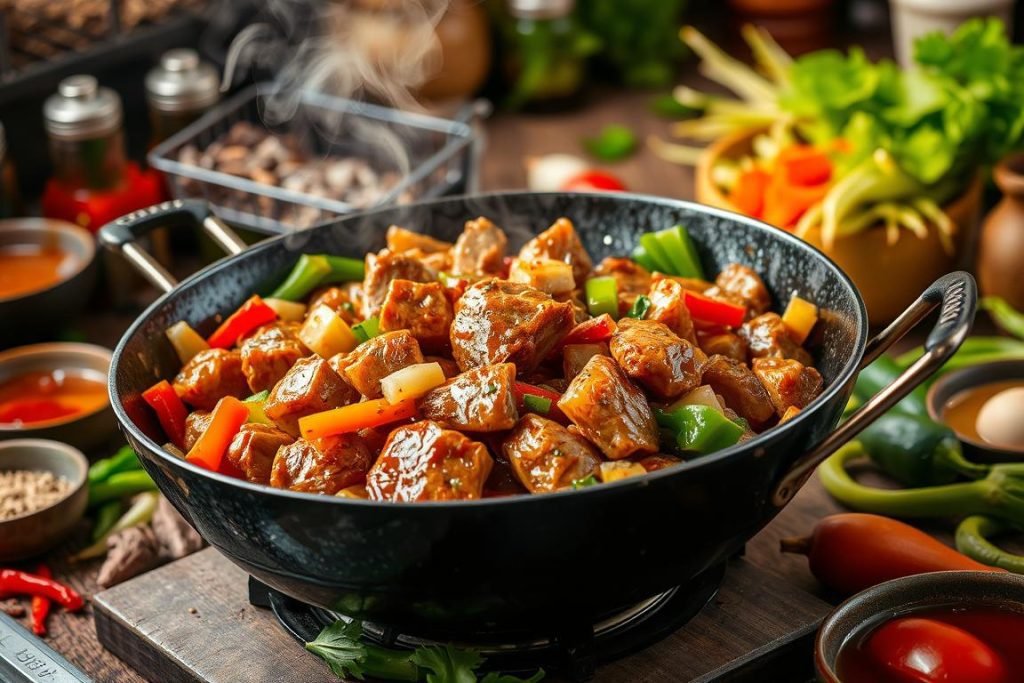Pro Stir-Fry Tips: Elevate Your Wok Game

Ever wonder why your stir-fries don’t taste like restaurant ones? Is the secret in mastering the wok, or are there Stir-Fry Technique Mastery secrets to learn? Learn the Stir-Fry Tips and Tricks to up your cooking game.
Key Takeaways
- Understanding the importance of mise en place to streamline your stir-fry process.
- Mastering high-heat cooking to achieve restaurant-quality wok hei.
- Realizing the crucial role of uniformly cutting ingredients for even cooking.
- Learning the art of not overcrowding your wok to maintain the ideal cooking temperature.
- Exploring various oils ideal for high smoke point requirements of stir-frying.
- Applying thickening techniques using cornstarch for the perfect stir-fry sauce.
Mastering Your Mise En Place for Faster Cooking
Getting good at mise en place is key for quick cooking, like when making a Meal Prep Stir Fry. This idea means having everything ready before you start. It helps you cook fast and well, especially with stir-fries.
Organizing Ingredients Before the Heat
Starting with a tidy kitchen puts you ahead for Quick Stir Fry Recipes. Have your meats, veggies, and spices ready. This makes cooking faster and keeps the tastes right by adding things at the best time.
Quick Access to Sauces and Seasonings
To improve your Stir-Fry Tips and Tricks, keep sauces and spices close. Have your oils and soy sauce ready on a shelf. Being able to move quickly is key to a great stir-fry.
Mise en place has been important since stir-frying started in China’s Eastern Zhou period. It’s always been about cooking fast and saving resources. Using mise en place fits right in with these ideas.
Using these meal prep stir fry tips will make your cooking better. Your stir-fries will be fast, yummy, and enjoyable to make.
Uniform Cutting: The Secret to Even Cooking
Uniform cutting of ingredients is key in Stir-Fry Technique Mastery. It ensures each part of your stir-fry cooks evenly. This prevents any piece from being too raw or too cooked.
Picture a Quick Stir Fry Recipe where every bell pepper slice and chicken strip is just right. Uniform cuts make the dish look, taste, and feel better.

Why is this uniformity so crucial? In a stir-fry’s quick cooking, size matters. Similar-sized pieces cook more evenly. They make the cooking process simpler for you, especially in fast-paced stir-fries.
| Ingredient | Prep Time | Cook Time |
|---|---|---|
| Proteins (Meat or Tofu) | 5 mins | 2-3 mins |
| Hard Vegetables (Carrots, Broccoli) | 5 mins | 1-2 mins |
| Soft Vegetables (Bell Peppers, Spinach) | 3 mins | 30-60 secs |
Start with aromatics like garlic and ginger. Add them to hot oil to let out their flavors. Then add your cut proteins and veggies in the right order. Knowing what oil to use is also key for Stir-Fry Technique Mastery. Choose ones like peanut or grapeseed that handle heat well.
Remember, when cooking a Quick Stir Fry Recipe, the size of your ingredients matters a lot. It’s not just for looks. It helps your food cook perfectly and makes your cooking better.
Choosing the Right Oil for High-Heat Cooking
Mastering high-heat cooking means choosing the right oil. It’s not just about taste. It’s also about health and how well your food turns out. The smoke point of an oil is super important. It’s the temp at which oil starts to smoke and break down, changing food’s taste and healthiness.

Knowing the smoke points of oils helps keep your healthy stir fry options both tasty and full of goodness. High smoke point oils like avocado, canola, and grapeseed are best for stir frying. They don’t break down quickly under high heat.
To make a great stir fry, choose the right oil and use it wisely. Start by heating your oil slowly. Then turn up the heat before adding your food. This keeps the oil good for longer. Also, pick oils that make your food taste even better.
| Oil Type | Smoke Point | Benefits |
|---|---|---|
| Canola Oil | 400°F | Low in saturated fat, high in monounsaturated fat |
| Grapeseed Oil | 420°F | High in polyunsaturated fats, good source of Vitamin E |
| Avocado Oil | 520°F | High smoke point, rich in oleic acid |
These oils are great for high-heat cooking and they’re healthy, too. Canola oil, for example, helps lower bad cholesterol. This lowers your risk of heart disease and stroke. And grapeseed oil’s fats improve heart health.
Choosing the right oil makes your stir fry better and healthier. Trying new oils adds fun and variety to your cooking. It makes your healthy stir fry options more exciting.
Stir-Fry Tips and Tricks: The Art of Not Overcrowding Your Wok
Mastering stir-fry starts with knowing how to use your wok. It’s important not to fill it too much. This helps your food sear well in the high heat needed.
Achieving the Perfect Sear
If your wok isn’t too full, food can touch the hot surface better. This makes it brown and tasty, not soggy. Cook food in small amounts for the best heat.
Maintaining High Wok Temperatures
Getting your wok hot enough is key for great stir-fry. Heat it until it smokes a bit before adding food. Use oils that can handle high heat, like refined olive or canola oil. These help food not stick and add a special flavor.

To really get good at stir-frying, balance the heat and give ingredients space. Pick the right oil too. With these tips, your meals will taste and look expertly made.
| Aspect | Importance | Tip |
|---|---|---|
| Wok Size | Crucial for proper heat distribution | Use at least a 14-inch wok |
| Oil Type | Ensures high heat tolerance and non-stick properties | Opt for oils like grapeseed or refined olive oil |
| Temperature | Key for searing and flavor development | Maintain high heat, preheat until smoky |
| Cooking Method | Affects texture and flavor | Avoid overcrowding, stir-fry in batches if necessary |
Sauce Making Mastery: Balancing Flavors
Making the perfect stir-fry is more than just mixing ingredients in a wok. It’s about sauce-making mastery to really make the dish special. Whether you want Healthy Stir Fry Options or to boost flavor, knowing Stir-Fry Sauces is crucial.

Thickening techniques are very important. A popular way is using cornstarch. It thickens sauces and makes them stick to your ingredients. This makes every bite better.
Thickening Techniques with Cornstarch
First, mix cornstarch with water to make a slurry. Add it to your stir-fry near the end of cooking. Heat makes it thicken. You’ll get a shiny, full sauce that brings your dish together.
Key Ingredients for a Flavorful Base
To make a great sauce, balance is key. Use soy sauce, hoisin, and oyster sauce for deep flavor and umami. Rice vinegar adds freshness, and Sriracha brings heat. Sesame oil gives a nutty finish. This mixes all flavors well.
Making the perfect sauce means balancing tastes well. Use the Stir-Fry Tip and Tricks to get it right. Mix richness with acid and spice carefully. You want to boost, not hide, your main ingredients’ flavors.
Think about health when you cook. Choose Healthy Stir Fry Options by using less salt and sugar. Making your sauces can be healthier. It lets you pick what goes into your dish.
Follow these tips to make your next stir-fry a balanced, tasty masterpiece. It will be both pleasing and good for you.
Protein Stir Fry: Ensuring Tender Meat Pieces
Making a great Protein Stir Fry is more than a simple task. You need to pay attention to your protein choice. Whether you pick beef, chicken, pork, or tofu, having tender pieces makes the meal delightful.
A key Stir-Fry Tip and Trick is slicing the protein thin. This helps it cook fast and soak up flavors. Marinating the protein with soy sauce, oil, and cornstarch keeps it tender when cooked at high heat.

How you cook is also crucial. Don’t put too much in the pan, or it might steam instead of sear. Here’s a tip from a Quick Stir Fry Recipe: Cook in small amounts. This gives each piece enough room to sear well.
| Protein Type | Preparation Tip | Cooking Time (Approx.) |
|---|---|---|
| Chicken | Thin slice, marinate | 5-7 minutes |
| Beef (Skirt Steak) | Velvet with baking soda, marinate | 2-3 minutes |
| Tofu (Firm) | Press to remove excess water, cube | 5-6 minutes |
| Shrimp | Peel, devein | 2-3 minutes |
Different sauces change the stir-fry’s taste. You can try oyster sauce or a sweet Mongolian sauce. These sauces make your dish taste great and please many tastes.
Lastly, use fresh ingredients for the best meal. Fresh veggies and quality proteins make a Protein Stir Fry both healthy and tasty.
Wok Hacks: Tools & Techniques for Superior Stir-Frying
Learning Wok Hacks and Stir-Fry Technique Mastery is key. This knowledge boosts your cooking skills, whether you’re cooking at home or aiming to be a chef.
Choosing the right wok is very important. For electric stoves, a 14-inch carbon steel wok works best. It’s great for high-heat cooking, giving food a tasty char without overcooking. A well-seasoned wok also adds to your food’s flavor.
To keep your wok in top shape, cook ginger and scallions in peanut oil for 15 to 20 minutes. This creates a nonstick surface that gets better every time you cook.

Cutting food into small, even pieces is key to good stir-frying. For example, chicken should be cut into ½-inch thick slices. This helps it cook evenly and quickly. Using high-quality ingredients, like organic chicken, also helps because of its better texture and taste.
Here are some additional Stir-Fry Tips and Tricks:
- Don’t put too much in your wok so it stays hot.
- Keep the heat high to cook fast and keep the food tasty and juicy.
- Use a wooden or silicone spatula to avoid scratching your wok.
| Cooking Technique | Benefits |
|---|---|
| High Heat Stir-Frying | Seals in flavors and juices for tastier dishes. |
| Deep-Frying | Causes less splatter and makes handling hot oil easier. |
| Wok Steaming | Good for cooking a variety of foods while keeping them nutritious. |
| Wok Braising | Gives simmered dishes more flavor. |
Using these Wok Hacks and techniques will make your cooking better. You’ll be able to make delicious stir-fried dishes right at home.
Vegetable Stir Fry: Perfect Texture and Nutrient Retention
Making a good Vegetable Stir Fry is more than just cooking veggies quickly. It’s about using High-Heat Cooking the right way and choosing your ingredients wisely. To get veggies that are “crisp-tender” and keep their bright colors, you need to know how to stir-fry properly.
Start with picking the right Healthy Stir Fry Options. The oil is very important. Use oils like avocado or olive that can handle the heat. They will cook your vegetables well without smoking. Also, cutting your vegetables the same size means they will cook evenly.
Here are some tips to keep your stir fry tasty and full of vitamins:
- Heat the wok before adding oil. This helps avoid sticky, soggy vegetables.
- Put hard vegetables like carrots and broccoli in first. Add softer ones like mushrooms and peppers later.
- Stir a lot and keep the heat up. This keeps the flavors and vitamins in.
- Use simple seasonings like sea salt and black pepper. They make natural tastes better without covering them up.
Stir-frying is not just fast. It also helps you eat well. This way of cooking keeps more vitamins than boiling does. A Vegetable Stir Fry is full of good stuff. Plus, you only need a little bit of oil. This makes it great for people who want to eat healthy.

You can also change up your stir-fry. Add different proteins or veggies to fit your diet or for fun. Here’s a quick look at what each ingredient adds to your Vegetable Stir Fry:
| Ingredient | Texture Contribution | Nutrient Retention |
|---|---|---|
| Broccoli | Crisp | High in Vitamin C |
| Carrots | Slightly crunchy | Rich in Vitamin A |
| Snow Peas | Tender | Good source of Iron |
| Mushrooms | Meaty texture | Contains Selenium |
| Bell Peppers | Soft, yet firm | High in Vitamin C |
For a great Vegetable Stir Fry, it’s all about the small things. From heating your wok to the last stir, everything counts. This makes sure your veggies keep their perfect texture, color, and vitamins. Enjoy a delicious dish that’s ready in 15 minutes. It’s quick, healthy, and great for any meal.
Healthy Stir Fry Options: Ingredient Swaps and Adjustments
Healthy Stir Fry Options help you eat better. They make meals full of nutrients without losing flavor. Use simple swaps and techniques to improve both taste and health benefits.
Try quinoa, lentils, or whole-grain noodles instead of white rice. These add more fiber and protein. Your meal becomes more balanced and filling.
Adding different veggies boosts your stir fry’s nutrition. Bell peppers, snap peas, and carrots make it colorful and healthy. Kale or spinach increase iron and calcium.
To lower sodium in stir-fry sauces, ease up on the soy sauce. Add some rice vinegar. It reduces salt and adds a nice tang, making flavors pop.
- Explore Quick Stir Fry Recipes that are tasty but healthy. They use lean proteins like chicken, shrimp, or tofu.
- Use Stir-Fry Tips and Tricks to cook fast. Prep ingredients early to avoid takeout temptations.

The success of a stir fry lies in its cooking technique. High heat and quick times keep veggies crisp and nutritious.
Be bold with flavors and textures to enjoy making stir fry. Try different sauces and spices to suit your taste. Each stir-fry can be unique and delicious.
With Healthy Stir Fry Options, you’re ready for quick, tasty meals. Explore Quick Stir Fry Recipes and Stir-Fry Tips and Tricks
for dinner tonight.Quick Stir Fry Recipes for Weeknight Dinners
Are you busy but still want a tasty, healthy dinner? Quick stir fry recipes are perfect. They’re easy to make and full of flavor. These meals are great for busy weeknights.
The Cashew Chicken stir fry is both fast and yummy. It mixes quick cooking with great taste. This makes it perfect for a speedy dinner.
Cashew Chicken: A Fast and Delightful Meal
This dish takes only 20 minutes to make. It serves 4 people and is quite nutritious. Here’s what you need for this filling meal:
- Chicken – an excellent source of protein
- Broccoli, bell peppers, and baby carrots – they add color and vitamins
- The sauce has honey, toasted sesame oil, soy sauce, chicken broth, cornstarch, and a bit of crushed red pepper flakes for heat
With these, the dish has 26g of protein, 13g of fat, and crunchy cashews. It’s a mix of tastes and textures.
Spicing Up Leftovers with a Stir-Fry Twist
Give your leftovers a new life with a stir-fry. It’s a great way to use what you have. Just add ginger and cashews for freshness and crunch. This turns simple leftovers into an exciting dish quickly.

Try these quick stir fry recipes for healthy and tasty meals on busy nights. They are easy to cook and work with any diet. These recipes are great for any night.
Conclusion
In the Stir-Fry Technique Mastery, your skill shines with fast heat and quick moves. This method, from Asia, makes cooking easy and adds rich flavors to your kitchen. Stir-frying links the past and present, showing how food styles merge over time.
Your stir-fry journey has taught you lots. You’ve learned to prep and choose the right oils for high heat. By slicing and seasoning well, you respect old traditions. You also make these traditions fit today’s love for Healthy Stir Fry Options.
The path to great meals is clear. It goes from careful prep to adding new twists to classic styles. Remember, no matter your pan, the spirit of stir-frying lives in the heat and your passion. So, use these Stir-Fry Tips and Tricks. Let cooking be a journey of culture and flavor, making each dish a tale of culinary creativity.